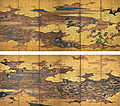Catalogue information
Edo period, early 18th century
Pair of six-panel folding screens; ink, color, gold, and silver on gilded paper
Each screen 156 x 362 cm (61 3/8 in. x 11 ft. 10 1/2 in.)
Donated to The Metropolitan Museum of Art, New York by the Mary and Jackson Burke Foundation in 2015
Literature
Ōta Shōko 1993, pp. 22–23
; 1993
“Byōbue o miru: ‘Taishokukan byōbu o megutte’” (Looking at screen painting: Concerning the screens of the Taishokukan story). In Miru yomu wakaru Nihon no rekishi: Genshi, kodai kara kindai, gendai made (Viewing, reading, and understanding Japanese history: From ancient times to recent and modern times), vol. 5, Jibun de yatte miyō (Let’s do it ourselves), edited by Shoseki Daiichi Henshūshitsu, pp. 18–31. Tokyo: Asahi Shinbunsha.
Murase 1993, no. 52
; 1993
Jewel Rivers: Japanese Art from the Burke Collection. Exh. cat. Richmond: Virginia Museum of Fine Art.
Buckland 2004, no. 5
; 2004
Golden Fantasies: Japanese Screens from New York Collections. Exh. cat. New York: Asia Society.
Tsuji Nobuo et al. 2005, no. 75.
2005
Nyūyōku Bāku korekushon-ten: Nihon no bi sanzennen no kagayaki / Enduring Legacy of Japanese Art: The Mary Griggs Burke Collection. Exh. cat., Museum of Fine Arts, Gifu; Hiroshima Prefectural Museum of Art; Tokyo Metropolitan Art Museum; and Miho Museum, Shigaraki, Shiga Prefecture. [Tokyo]: Nihon Keizai Shinbunsha.
See also
- Japanese paintings » Screens by Unidentified Artists of the Momoyama and Edo Periods
- Screens
- Works of the Edo period
This artwork was published as catalogue entry 209 in Volume I of Art through a Lifetime.



